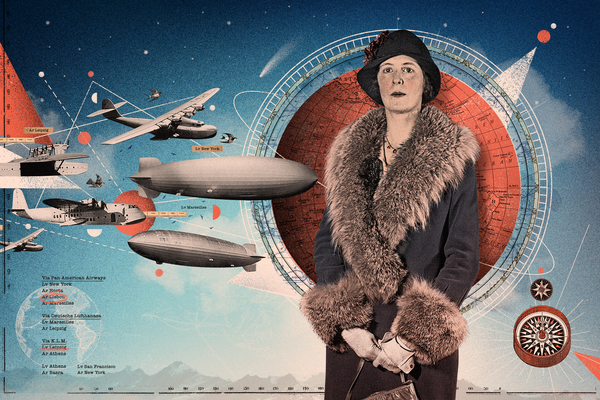The Controversial Zeppelin Stamps That Enraged 1930s Collectors
The U.S. Post Office ended up destroying most of them.
On May 21, 1930, the world’s biggest airship, the Graf Zeppelin, floated over the Cape Verde Islands and slowed down over an unusual target: the Porto Praia post office. When the ship had maneuvered to just the right spot, its crew threw something out of the gondola, attached to a small parachute. As frightened crowds gathered below to watch, the mysterious object fluttered down from the sky and landed right on the building’s roof. It was a big sack of mail.
Over the next few weeks, the Graf Zeppelin would complete its first Pan-American tour, flying to Rio de Janeiro, Ohio, and New Jersey, and then back over the Atlantic to Spain and its home country, Germany. Although much glitz and glamour accompanied the airship’s comings and goings, its journey was funded by something more mundane: those sacks of mail, via the stamps affixed to the letters inside.

At 775 feet from nose to tail—about as long as the Golden Gate Bridge is tall—the Graf was the largest flying machine the world had ever seen. Its operating costs were proportionate, clocking at about $4 per mile (or $54 per mile in today’s money). Although passengers paid steep ticket prices, especially on early flights, the ship could only hold about 20 of them at a time, limiting that revenue stream. And despite the fanfare that greeted its every move, attempts to charge admission to view it on the ground didn’t go over well with the public, who were generally hurting from the Great Depression, and who wanted their close-ups for free.
Instead, the Graf’s parent company, German Zeppelin Airship Works, decided to recoup costs by commissioning special stamps from the countries on the tour route. Only letters with these stamps on them would be accepted onto the airship, which would then deliver them to their destinations. This was the only commercial transatlantic air mail option available at the time, and was days faster than sending a letter by boat. Brazil, Bolivia, Germany, and Spain all made the Zeppelin stamps, and 93 percent of the proceeds from each stamp was funneled back into German Zeppelin Airship Works.

After some debate, the U.S. Post Office decided to get in on the game as well, designing and printing a run of Graf Zeppelin stamps in a matter of weeks. They called this a gesture of goodwill toward Germany, and pledged to also contribute 93 percent of the revenue to the Airship Works. Secretly, though, they expected that an enthusiastic population of American collectors would snap up most of the stamps, keeping them out of circulation, and ensuring that the Post Office held onto most of the money.
So on April 19, 1930, the USPO issued three stamps, each with a different design and for a particular amount. The first, a 65-cent stamp, was green, and showed the Graf cruising eastward above the sea. This stamp would get a postcard over the ocean once, from the U.S. or Brazil to Spain or Germany. The second, a $1.30 stamp, was brown, and featured the zeppelin heading west over a cropped map of the world labeled with the tour’s three main cities (although New York, here, stands in for New Jersey). That one would get a letter across the sea.

The last stamp, in a bright sky blue, cost $2.60, and displayed the Graf high in the clouds, superimposed over a small globe. This one was more fun than practical—it would get your letter round-trip, over to Europe and then back again. (One young boy from Ontario sent himself a letter this way, and made the papers.) The stamps’ release was trumpeted in newspapers from New York City to Santa Cruz.
The joke, though, was on the post office. The economic hardship that led so many Depression-era Americans to be buoyed by the sight of a massive airship also made it difficult for any of them to pay $4.55—50 times the cost of a loaf of bread—for a set of three collectible stamps. The U.S. printed 1,000,000 of each color, but only sold about 227,000 zeppelin stamps total, most of which actually did end up on mail delivered by the Graf.
The Post Office eventually destroyed the remainder of the stamps, making collectors, who quickly accused them of creating artificial scarcity, even angrier. But that’s what happens when you try to cross the world’s biggest zeppelin.
Stamp of Approval is an occasional column that explores the designs and backstories of the world’s strangest stamps. Have a stamp you want investigated? Stick it in an email to [email protected].











Follow us on Twitter to get the latest on the world's hidden wonders.
Like us on Facebook to get the latest on the world's hidden wonders.
Follow us on Twitter Like us on Facebook